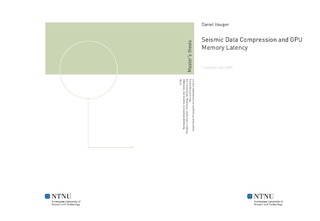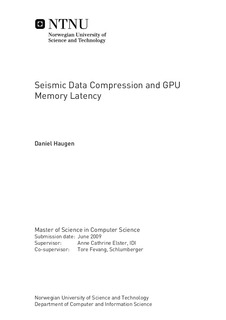| dc.contributor.advisor | Elster, Anne Cathrine | nb_NO |
| dc.contributor.advisor | Fevang, Tore | nb_NO |
| dc.contributor.author | Haugen, Daniel | nb_NO |
| dc.date.accessioned | 2014-12-19T13:34:04Z | |
| dc.date.available | 2014-12-19T13:34:04Z | |
| dc.date.created | 2010-09-04 | nb_NO |
| dc.date.issued | 2009 | nb_NO |
| dc.identifier | 348900 | nb_NO |
| dc.identifier | ntnudaim:4837 | nb_NO |
| dc.identifier.uri | http://hdl.handle.net/11250/251394 | |
| dc.description.abstract | The gap between processing performance and the memory bandwidth is still increasing. To compensate for this gap various techniques have been used, such as using a memory hierarchy with faster memory closer to the processing unit. Other techniques that have been tested include the compression of data prior to a memory transfer. Bandwidth limitations exists not only at low levels within the memory hierarchy, but also between the central processing unit (CPU) and the graphics processing unit (GPU), suggesting the use of compression to mask the gap. Seismic datasets are often very large, e.g. several terabytes. This thesis explores compression of seismic data to hide the bandwidth limitation between the CPU and the GPU for seismic applications. The compression method considered is subband coding, with both run-length encoding (RLE) and Huffman encoding as compressors of the quantized data. These methods has shown on CPU implementations to give very good compression ratios for seismic data. A proof of concept implementation for decompression of seismic data on GPUs is developed. It consists of three main components: First the subband synthesis filter reconstructing the input data processed by the subband analysis filter. Second, the inverse quantizer generating an output close to the input given to the quantizer. Finally, the decoders decompressing the compressed data using Huffman and RLE. The results of our implementation show that the seismic data compression algorithm investigated is probably not suited to hide the bandwidth limitation between CPU and GPU. This is because of the steps taken to do the decompression are likely slower than a simple memory copy of the uncompressed seismic data. It is primarily the decompressors that are the limiting factor, but in our implementation the subband synthesis is also limiting. The sequential nature of the decompres- sion algorithms used makes them difficult to parallelize to make use of the processing units on the GPUs in an efficient way. Several suggestions for future work is then suggested as well as results showing how our GPU implementation can be very useful for data compres- sion for data to be sent over a network. Our compression results give a compression factor between 27 and 32, and a SNR of 24.67dB for a cube of dimension 643. A speedup of 2.5 for the synthesis filter compared to the CPU implementation is achieved (2029.00/813.76 2.5). Although not currently suited for the GPU-CPU compression, our implementations indicate | nb_NO |
| dc.language | eng | nb_NO |
| dc.publisher | Institutt for datateknikk og informasjonsvitenskap | nb_NO |
| dc.subject | ntnudaim | no_NO |
| dc.subject | SIF2 datateknikk | no_NO |
| dc.subject | Komplekse datasystemer | no_NO |
| dc.title | Seismic Data Compression and GPU Memory Latency | nb_NO |
| dc.type | Master thesis | nb_NO |
| dc.source.pagenumber | 91 | nb_NO |
| dc.contributor.department | Norges teknisk-naturvitenskapelige universitet, Fakultet for informasjonsteknologi, matematikk og elektroteknikk, Institutt for datateknikk og informasjonsvitenskap | nb_NO |

